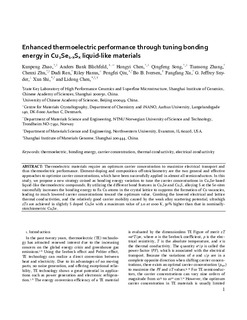| dc.contributor.author | Zhao, Kunpeng | |
| dc.contributor.author | Blichfeld, Anders Bank | |
| dc.contributor.author | Chen, Hongyi | |
| dc.contributor.author | Zhang, Tiansong | |
| dc.contributor.author | Zhu, Chenxi | |
| dc.contributor.author | Ren, Dudi | |
| dc.contributor.author | Hanus, Riley | |
| dc.contributor.author | Qiu, Pengfei | |
| dc.contributor.author | Iversen, Bo B | |
| dc.contributor.author | Xu, Fangfang | |
| dc.contributor.author | Snyder, G. Jeffrey | |
| dc.contributor.author | Xun, Shi | |
| dc.contributor.author | Chen, Lidong | |
| dc.date.accessioned | 2018-03-07T09:23:14Z | |
| dc.date.available | 2018-03-07T09:23:14Z | |
| dc.date.created | 2017-09-18T09:48:04Z | |
| dc.date.issued | 2017 | |
| dc.identifier.citation | Chemistry of Materials. 2017, 29 (15), 6367-6377. | nb_NO |
| dc.identifier.issn | 0897-4756 | |
| dc.identifier.uri | http://hdl.handle.net/11250/2489063 | |
| dc.description.abstract | Thermoelectric materials require an optimal carrier concentration to maximize electrical transport and thus thermoelectric performance. Element doping and composition off-stoichiometry are the two general and effective approaches for optimizing carrier concentrations, which have been successfully applied in almost all semiconductors. In this study, we propose a new strategy called bonding energy variation to tune the carrier concentrations in Cu2Se-based liquid-like thermoelectric compounds. By utilizing the different bond features in Cu2Se and Cu2S, alloying S at the Se sites successfully increases the bonding energy to fix Cu atoms in the crystal lattice to suppress the formation of Cu vacancies, leading to greatly reduced carrier concentrations toward the optimal value. Via a combination of the lowered electrical and lattice thermal conductivities and the relatively good carrier mobility caused by the weak alloy scattering potential, ultrahigh zT values are achieved in slightly S-doped Cu2Se with a maximal value of 2.0 at 1000 K, 30% higher than that in nominally stoichiometric Cu2Se. | nb_NO |
| dc.language.iso | eng | nb_NO |
| dc.publisher | American Chemical Society | nb_NO |
| dc.title | Enhanced Thermoelectric Performance through Tuning Bonding Energy in Cu2Se1–xSx Liquid-like Materials | nb_NO |
| dc.type | Journal article | nb_NO |
| dc.type | Peer reviewed | nb_NO |
| dc.description.version | acceptedVersion | nb_NO |
| dc.source.pagenumber | 6367-6377 | nb_NO |
| dc.source.volume | 29 | nb_NO |
| dc.source.journal | Chemistry of Materials | nb_NO |
| dc.source.issue | 15 | nb_NO |
| dc.identifier.doi | 10.1021/acs.chemmater.7b01687 | |
| dc.identifier.cristin | 1494627 | |
| dc.relation.project | Norges forskningsråd: 250403 | nb_NO |
| dc.description.localcode | © American Chemical Society 2017. This is the authors accepted and refereed manuscript to the article. Locked until 24.7.2018 due to copyright restrictions. | nb_NO |
| cristin.unitcode | 194,66,35,0 | |
| cristin.unitname | Institutt for materialteknologi | |
| cristin.ispublished | true | |
| cristin.fulltext | preprint | |
| cristin.qualitycode | 2 | |
